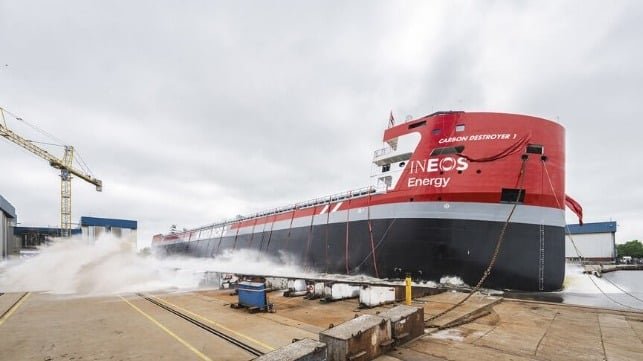The Launch of Europe’s First CO2 Carrier for CCS Operations
The first European-designed and built carrier for liquified CO2 to be used in a carbon capture and storage operation was launched on May 14 in the Netherlands. The vessel, named Carbon Destroy 1, marks a significant breakthrough in supporting a commercial-scale CCS project for the EU.
The launch ceremony took place at the Royal Niestern Sander shipyard, where the vessel was unveiled. The Carbon Destroy 1 is designed to transport approximately 5,000 tons of liquified CO2 as part of the Greensand Future project. This project aims to capture and store CO2 from various sources across Europe.
Technical Details of the Vessel
The Carbon Destroy 1 is based on Royal Wagenborg’s EasyMax shortsea bulker design, specially adapted for handling CO2 under pressure and low temperature conditions. With a cargo capacity of 14,000 tons, the vessel is designed for efficient and safe transportation of CO2. The vessel has a length of 492 feet, a beam of 52 feet, and a draught of 28 feet, providing an enlarged cargo capacity.
Mads Weng Gade, CEO of INEOS Energy Europe, emphasized the vessel’s role in creating a virtual pipeline for transporting captured CO2 from various European locations to permanent storage deep beneath the seabed of the North Sea.
Future Operations and Expansion
The vessel is expected to be fully operational by the end of 2025 or early 2026, coinciding with the projected start of commercial operations for the Greensand project. The project aims to store over 1,800 meters beneath the seabed and initially plans to capture, transport, and store 400,000 tons of CO2 per year, with potential for expansion by 2030.
Additionally, the Carbon Destroy 1 is part of a larger initiative involving INEOS Energy Denmark, Harbour Energy, and Nordsøfonden, aiming to achieve permanent storage of up to 8 million tons of CO2 annually.
Comparison with Existing Vessels
The Carbon Destroy 1 surpasses the capacity of two South Korean-built vessels delivered for Norway’s Northern Lights CCS project. These vessels, with a capacity of 7,500 cbm of LCO2 each, have already received necessary permits for CO2 injection off the Norwegian coast.
Overall, the launch of the Carbon Destroy 1 represents a major milestone in advancing carbon capture and storage technologies in Europe, setting the stage for more sustainable practices in the future.

